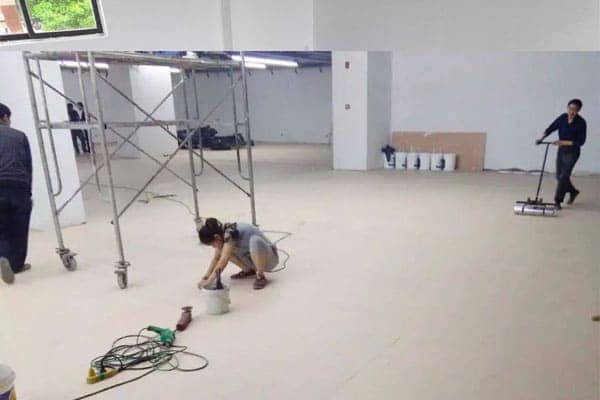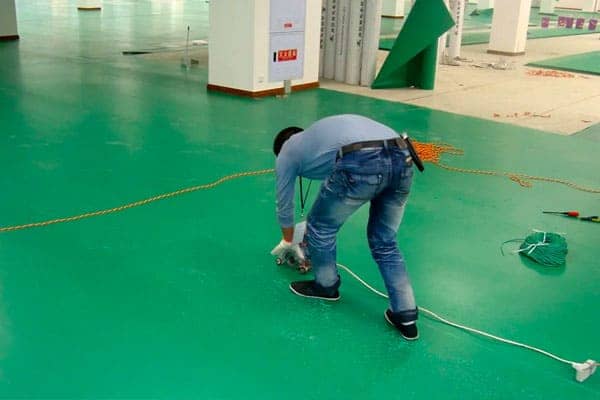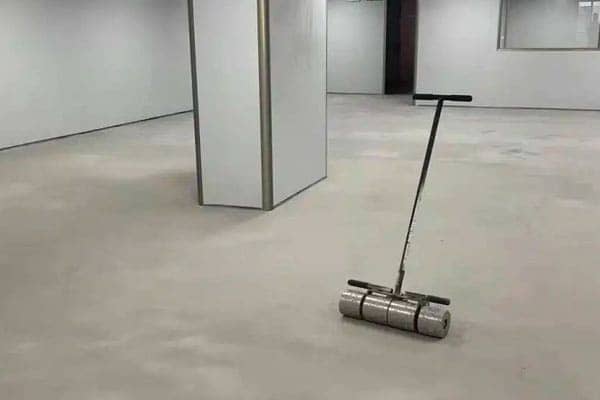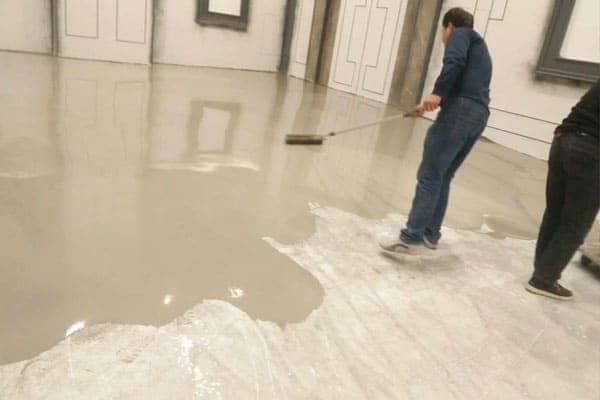PVC roll flooring is a plastic material you can install to make indoor floors. However, it is more commonly used indoors because of its waterproofing qualities. In addition, this flooring product is made from recycled materials, making it environmentally friendly.

PVC roll flooring is useful and multifunctional in many ways, including replacing rubber floors or carpeting. You can also use it on top of concrete floors, metal floors, traditional hardwood floors, or laminate floors. In addition, PVC flooring roll applies in various areas such as office spaces, subway cars, public subway stations, shopping malls, supermarkets, schools, apartment buildings, sports, hospitals, clinics, and stores.
Before you commence the installation of your PVC flooring roll, consider these six steps:
Step 1: The ground requirements before you can install PVC roll flooring
- The ground’s surface should be smooth, with high compaction, to ensure that the floor is firmly fixed.
- Make the size of the hole in which you want to install PVC flooring according to the thickness of your floor.
You can choose from two types: small-sized holes (for example, 3mm or 4mm) or large-sized holes (for example, 8 mm or 10 mm).
- The thickness of the PVC flooring should not be less than 2 mm, no matter which direction it is laid.
- Use a hot melt gun or self-leveling adhesive to flat the PVC flooring because they are flexible, long-lasting, and easy to install.
- For best results, allow at least 24 hours before your floor covering. During this process, dust will settle. In addition, it will make it easier to apply your new flooring smoothly and evenly across your room’s surface. Also, it won’t create wrinkles or creases in the material where it meets up with itself.

Step2: PVC Roll Flooring Installations Tools
To install your PVC flooring roll, you must get the right tools for the best installation. These tools are a quarter-moon knife, gloves, a trowel, a welding rod, a hand welding tool or automatic welding machine, tape measure, double-sided tape, a level, a soft brush, 2-by-4 lumber (for a frame), a framing Square, a pencil, a drill with an appropriate bit (for screws, not nails), adhesive, and other relevant tools.
Step 3: Prepare the Base Floor for PVC Roll Flooring Installation
The first step in installing PVC Roll flooring is to prepare the floor’s surface by removing dust or debris. This step is important if you have hardwood floors, as they can act like magnets for the glue and cause permanent damage to your flooring. Also, ensure no obstacles, such as pipes or electrical cables, are in the way. Once you have cleared anything that could get in the way, take a ruler, measure off a length of 10 feet, and mark it up at both ends (lengthwise).
If you observe varying levels, hollow spots, or cracks, you must fill them up to ensure your base floor is evenly flat. For the wooden floor, use plywood sheets to level the floor up by using screws and base paint. Cover up the uneven concrete floor with a filling mixture that matches. You can use a grinder to level up if yours is a concrete floor. Ensure your base floor is dry, free of debris or dust, and hard before installing the PVC roll flooring.

Step 4: Preparing the PVC Roll Flooring for Installation
To prepare for your PVC roll flooring installation, place your PVC roll flooring in the room for 24 hours to relax and acclimatize to the room’s temperature. Then, plan a perfect layout for your PVC roll flooring to achieve your desired outlook.
Step 5: Mark out the area of the surface
Roll out your pieces of PVC vinyl onto a flat surface where you can see them clearly from all angles to ensure each piece fits together well and evens out properly before moving on to the next step in the installation process. Mark out the area where you will place the new flooring. Make sure it is big enough for your needs to fit in well with other rooms in the house.
Step 6: Laying of the PVC Roll Flooring
- Fold one-half layer of PVC flooring on the floor surface and work on the free space.
- Spread your adhesive glue to a thin layer with your trowel.
- Spread out your folded one-half PVC flooring roll and avoid wrinkles. Ensure you clear any bubbles by pushing the PVC roll flooring out properly.
- Follow the procedure for the other half.
- Please give it a finishing touch by trimming the seam to the wall and applying base trim.

The General Ground Type
There are many types of flooring that you can choose from to install PVC roll flooring. For the base floor, you cannot install PVC roll flooring on these types: carpets, flexible plastic coverings, old vinyl floors, and tiles. You can also install your PVC roll flooring on a concrete slab, wooden floor, or linoleum coverings. Ensure this sub base is dry, clean, hard, flat, and damp free.
Concrete
This is the most common type of flooring for installations. It has the advantage of being durable and easy to clean, but it doesn’t offer much visual appeal. The major downside is that concrete floors heat up during the day and cool down at night, which can lead to condensation in humid climates. To prevent this, you must use temperature and humidity devices to discover how perfect the floor is for installation. Ensure the temperature is between 10 and 30 C, while the humidity should appear at 20% to 75%. In addition, ensure the base ground is well-leveled and flat.
Installation of PVC Roll Flooring on Concrete floor
You will need to use a concrete cutting knife to install PVC Roll flooring on a concrete floor. The first step is to mark where you would like the new PVC Roll flooring installed.
When marking the area, ensure you know how much width and length you want your new PVC Roll flooring.
Once you have determined where to install your new PVC Roll flooring, it’s time to spread one-half of it out. First, add some adhesive to the open base using a hand trowel or roller. After that procedure, spread your folded roll on the glued floor and do the same for the other half.

Wood
When installing PVC roll flooring on a wooden floor, it is important to consider the type of wood used. For example, a softwood or hardwood floor will have a different hardness level from an engineered wood floor. If you are installing PVC roll flooring on a wooden floor and are unsure about the type of wood, you must consult your local building inspector before proceeding with the installation.
Installation of PVC Roll Flooring on a Wooden Floor
The first step in installing PVC Roll flooring on a wooden floor is to measure the floor. It will help if you were sure that the vinyl roll would fit over the wooden planks and not overlap them at any point. Next, remove any baseboards and make the floor leveled. Next, mark off where you want to place your PVC Roll flooring. You may use a chalk line or pencil lead for this task. It is best if you have someone else help you with this part of the process, as it can be time-consuming and dangerous if you attempt to do it alone once you have marked off where you want to place your vinyl roll, cut along each line that you have drawn with an Exacto knife or other sharp cutting tool.
Now that you have marked off where your PVC Roll flooring will go across your wooden floor, it’s time to install it! First, pull out one end of each plank and lay them down onto their side, so they’re ready for your vinyl roll (and vice versa). Then pull out one end of your vinyl roll and lay it down over these planks until they all meet together.

Linoleum
This flooring has even less appeal than concrete, but it’s still a superb choice if you want something durable and easy to maintain (especially if you live in an area where it gets slippery). Linoleum also has a high Mohs hardness rating, which makes it durable against scratches and scuffs.
What is Self-Leveling?
A self-leveling floor is a vinyl flooring system that you can install on a concrete or wood subfloor. The system eliminates the need for a professional installer. Instead, homeowners can install their floors by following the simple step-by-step instructions provided in the package. It’s a fast, easy way to add beauty and value to any home while saving money. Self-leveling floors are durable materials that withstand heavy foot traffic throughout the day.
The most important feature of this type of flooring is its ability to self-level itself as it is laid down in your home. As a result, you won’t have to worry about uneven edges or bumps in your floors as you move around during construction or renovation projects. Once installed, these floors will remain flat with no additional work on your part!
Self-leveling vinyl flooring comes in many styles and colors, so there’s something for everyone’s taste! You can choose from designs that resemble traditional hardwood floors or even ceramic tile options that look made from stone or marble!
Quick note: Be careful when cutting PVC materials to avoid damaging the material.

Construction precautions of PVC Flooring
There are several precautions to take before laying your PVC flooring. One of the important steps to take is to protect the floors from any damage caused by moisture during installation. Ensure you use weather-stripping around doors, windows, and vents. This procedure will help prevent moisture from entering your walls and seal off unwanted drafts in your home. The good idea is to invest in some Tyvek tape which protects surfaces from moisture. Other chemicals like oil and grease, which can seep through cracks in walls, will also help.
Use a tarp to cover up any furniture or other items that need protection from the chemicals used during installation (such as glass vases or ceramic tiles). The tarp will also protect against spills or drips from accidentally hitting nearby surfaces.
Choose a high-quality manufacturer for your floor to avoid a stressful installation experience. When choosing a manufacturer for your project, you must choose a company with an excellent reputation in the industry, like Bantro flooring. In addition, check out the warranty offered by each company before deciding.
Read more here to know how to find other reliable PVC suppliers.
The flooring can crack or break if it warms up and becomes moist. Water can also seep into PVC flooring, causing it to swell and become brittle. To prevent this situation, avoid letting water sit on the floor overnight or for longer periods. If you need to leave your floors wet for any time, drain them completely before applying additional coats of sealant.


